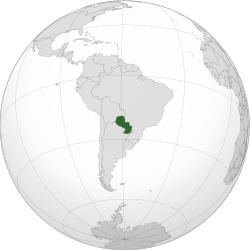Republic of Paraguay | |
|---|---|
| Motto: Paz y justicia (Spanish) "Peace and justice" | |
| Anthem: Himno Nacional Paraguayo (Spanish) "Paraguayan National Anthem" | |
 Location of Paraguay (dark green) in South America (grey) | |
| Capital and largest city | Asunción 25°16′S 57°40′W / 25.267°S 57.667°W |
| Official languages[1][2] | |
| Religion (2020)[3] |
|
| Demonym(s) | Paraguayan |
| Government | Unitary presidential republic |
| Santiago Peña | |
| Pedro Alliana | |
| Silvio Ovelar | |
| Raul Latorre | |
| César Diesel | |
| Legislature | Congress |
| Senate | |
| Chamber of Deputies | |
| Independence from Spain | |
• Declared | 14 May 1811 |
• Recognized | 25 November 1842 |
| 20 June 1992 | |
| Area | |
• Total | 406,752 km2 (157,048 sq mi) (59th) |
• Water (%) | 2.6 |
| Population | |
• 2024 estimate | 6,218,879[4] (113rd) |
• 2022 census | 6,109,903[5] |
• Density | 39/sq mi (15.1/km2) (223rd) |
| GDP (PPP) | 2024 estimate |
• Total | |
• Per capita | |
| GDP (nominal) | 2024 estimate |
• Total | |
• Per capita | |
| Gini (2022) | 45.1[7] medium inequality |
| HDI (2022) | high (105th) |
| Currency | Guaraní (PYG) |
| Time zone | UTC–3 (PYT) |
| Date format | dd/mm/yyyy |
| Drives on | right |
| Calling code | +595 |
| ISO 3166 code | PY |
| Internet TLD | .py |
Paraguay (/ˈpærəɡwaɪ/; Spanish pronunciation: [paɾaˈɣwaj] ), officially the Republic of Paraguay (Spanish: República del Paraguay; Guarani: Paraguái Tavakuairetã), is a landlocked country in South America. It is bordered by Argentina to the south and southwest, Brazil to the east and northeast, and Bolivia to the northwest. It has a population of around 6.1 million, nearly 2.3 million of whom live in the capital and largest city of Asunción, and its surrounding metro area.
Spanish conquistadores arrived in 1524, and in 1537 established the city of Asunción, the first capital of the Governorate of the Río de la Plata.[9] During the 17th century, Paraguay was the center of Jesuit missions, where the native Guaraní people were converted to Christianity and introduced to European culture.[10] After the expulsion of the Jesuits from Spanish territories in 1767, Paraguay increasingly became a peripheral colony. Following independence from Spain in the early 19th century, Paraguay was ruled by a series of authoritarian governments. This period ended with the disastrous Paraguayan War (1864–1870), during which the country lost half its prewar population and around 25–33% of its territory. In the 20th century, Paraguay faced another major international conflict—the Chaco War (1932–1935) against Bolivia—in which Paraguay prevailed. The country came under a succession of military dictators, culminating in the 35-year regime of Alfredo Stroessner, which lasted until his overthrow in 1989 by an internal military coup. This marked the beginning of Paraguay's current democratic era.
Paraguay is a developing country, ranking 105th in the Human Development Index.[11] It is a founding member of Mercosur, the United Nations, the Organization of American States, the Non-Aligned Movement and the Lima Group. Additionally, the city of Luque, in metropolitan Asuncion, is the seat of the South American Football Confederation.
Although one of only two landlocked countries in South America (Bolivia is the other), Paraguay has ports on the Paraguay and Paraná rivers that give exit to the Atlantic Ocean, through the Paraná-Paraguay Waterway.[12] The majority of Paraguay's 6 million people are mestizo, and Guarani culture remains widely influential; more than 90% of the population speak various dialects of the Guarani language alongside Spanish. Paraguay's GDP per capita PPP is the seventh-highest in South America. In a 2017 Positive Experience Index based on global polling data, Paraguay ranked as the "world's happiest place".[13]
Cite error: There are <ref group=lower-alpha> tags or {{efn}} templates on this page, but the references will not show without a {{reflist|group=lower-alpha}} template or {{notelist}} template (see the help page).
- ^ "Article 140 about Languages". Paraguay – Constitution. International Constitutional Law Project. Archived from the original on 14 August 2012. Retrieved 3 December 2007. (see "translator's note". Archived from the original on 1 February 2017.)
- ^ "8 LIZCANO" (PDF). Convergencia.uaemex.mx. Archived from the original (PDF) on 15 January 2013. Retrieved 5 October 2012.
- ^ "National Profiles | World Religion". Archived from the original on 1 October 2023. Retrieved 12 March 2024.
- ^ "Geostatistical viewer: Population, districts, poverty, road and water coverage, etc". INE Paraguay (in Spanish). 20 January 2024.
- ^ "Paraguay Census 2022 - Final Results" (PDF). INE Paraguay (in Spanish). Retrieved 21 August 2024.
- ^ a b c d "World Economic Outlook Database: Paraguay". IMF.org. International Monetary Fund. April 2024. Archived from the original on 28 April 2024. Retrieved 30 April 2024.
- ^ "Gini Index". World Bank. Archived from the original on 6 July 2022. Retrieved 6 July 2022.
- ^ "Human Development Report 2023/2024" (PDF). United Nations Development Programme. Archived (PDF) from the original on 13 March 2024. Retrieved 24 March 2024.
- ^ "Paraguay: Cómo Asunción se convirtió en 'madre' de más de 70 ciudades de Sudamérica hace 480 años". BBC News Mundo. British Broadcasting Corporation. Archived from the original on 18 September 2018.
- ^ Caraman, Philip (1976). The Lost Paradise: The Jesuit republic in South America. New York, NY: Seabury Press.
- ^ "World Economic Outlook Database". IMF.org. International Monetary Fund. April 2019. Archived from the original on 10 October 2020. Retrieved 29 September 2019.
- ^ "Paraná-Paraguay Waterway" (PDF) (in Spanish). Archived from the original (PDF) on 27 March 2019. Retrieved 20 October 2015.
- ^ "World's happiest country? Would you believe Paraguay?". NBC News (nbcnews.com). 21 May 2014. Archived from the original on 14 September 2018. Retrieved 19 September 2018.

![Seal [a] of Paraguay](http://upload.wikimedia.org/wikipedia/commons/thumb/7/70/Coat_of_arms_of_Paraguay.svg/85px-Coat_of_arms_of_Paraguay.svg.png)